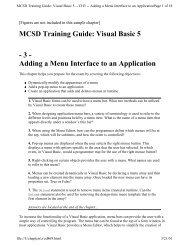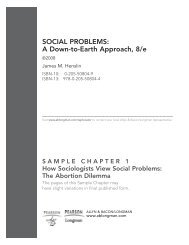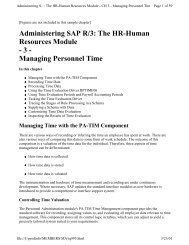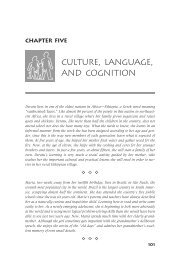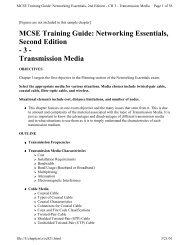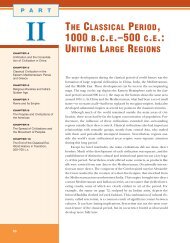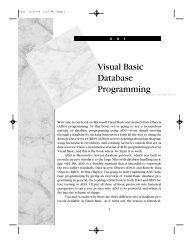Phonetic Transcription and Diacritics
Phonetic Transcription and Diacritics
Phonetic Transcription and Diacritics
Create successful ePaper yourself
Turn your PDF publications into a flip-book with our unique Google optimized e-Paper software.
44 CHAPTER 3<br />
perceived at times as [ s� ], at other times as [θ]. It is<br />
interesting to note, however, that certain children<br />
may also use this dichotomy systematically: [θ] may<br />
be realized initiating words or syllables, while [ s� ] is<br />
produced terminating words or syllables, for example.<br />
Such a possibility should be considered in our<br />
assessment.<br />
Differentiating between dentalized, palatalized,<br />
<strong>and</strong> lateralized [s]-productions may seem diffi cult<br />
at fi rst. However, there are clear perceptual qualities<br />
that distinguish the three forms of [s] actualization.<br />
Dentalized [s]-sounds, [ s� ], have a “dull” quality; they<br />
lack the sharp, high-frequency characteristic of typical<br />
[s]- productions. On the other h<strong>and</strong>, lateralized [s]sounds,<br />
[�], have a distinct noise component to them<br />
that is typically as disagreeable as it is conspicuous.<br />
Palatalized [s] variations, [s� ], approach perceptually a<br />
[ ʃ ] quality. Palatalization of [s] is marked by the anterior<br />
portions of the tongue approaching parts of the<br />
palate resulting in a somewhat posterior placement<br />
of the organ <strong>and</strong> place of articulation. Comparing the<br />
production features of [s] to [ ʃ ], one notes that [ ʃ ]<br />
realizations also require a more posteriorly placed organ<br />
<strong>and</strong> place of articulation (apico-alveolar [s] versus<br />
coronal-prepalatal [ ʃ ]).<br />
Voice Symbols<br />
Devoicing of Voiced Consonants. Under normal<br />
circumstances, vowels <strong>and</strong> more than half of<br />
our consonants are voiced. If these sounds become<br />
devoiced in a speech sample, it needs to<br />
be marked. In cases of total devoicing, the IPA<br />
symbol for the voiceless counterpart of the<br />
voiced sound, its unvoiced cognate, is usually<br />
indicated:<br />
[ ʃus] for “shoes”<br />
[brεt] for “bread”<br />
Partial Devoicing. Often, however, the sound<br />
in question is only partially devoiced. The diacritic<br />
for partial devoicing is a small circle in<br />
parentheses placed under the sound symbol:<br />
[ ʃuz ���]<br />
[brεd���]<br />
The extIPA also differentiates initial devoicing<br />
[ �� ] <strong>and</strong> fi nal devoicing [ �� ].<br />
Voicing of Voiceless Consonants. Voiceless consonants<br />
may also be voiced, especially if they<br />
occur between two vowels. A casual pronunciation<br />
of eighteen might serve as an example.<br />
If voiceless consonants become totally voiced,<br />
the segment is transcribed with the respective<br />
symbol:<br />
[e I tin] → [e I din]<br />
Partial Voicing. If voiceless consonants become<br />
partially voiced, the diacritical mark is<br />
a lowercase v in parentheses under the respective<br />
sound symbol:<br />
[ei���in] t for “eighteen”<br />
Initial <strong>and</strong> fi nal partial voicing are [��] <strong>and</strong> [��],<br />
respectively.<br />
CLINICAL COMMENTS<br />
Partial voicing <strong>and</strong> devoicing are diffi cult to discern<br />
<strong>and</strong> to transcribe correctly. The fi rst impression of<br />
transcribers is often some minor qualitative variance—<br />
the sound is somehow “off.” Such a fi rst impression is<br />
usually a good reason to focus subsequently on the<br />
voicing–devoicing opposition. This two-step procedure<br />
makes it easier to arrive at the diffi cult judgment:<br />
partially voiced or partially devoiced.<br />
Also, in General American English, there is a tendency<br />
to devoice (or partially devoice) fi nal consonants.<br />
The following are examples from Daniel, age<br />
4;7.<br />
“stove” [stoυv] → [stoυf] total devoicing<br />
“slide” [slaid] → [slaid��] partial devoicing<br />
“fl ag” [fl �g] → [fl �g��] partial devoicing<br />
“nose” [noυz] → [noυs] total devoicing<br />
The general devoicing tendency in fi nal positions suggests<br />
that realizations like these should probably not<br />
be considered aberrant productions.





